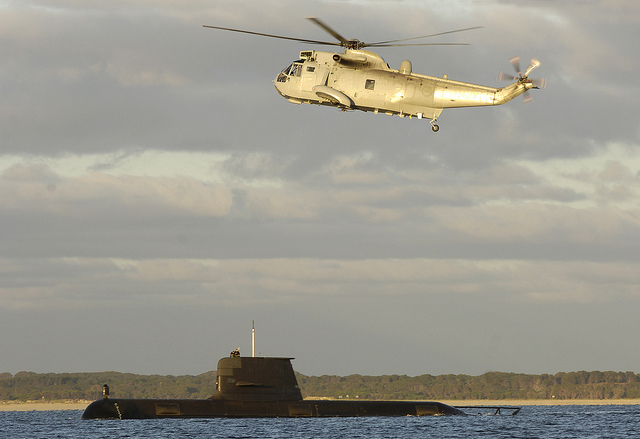Mobility, endurance, and payload: lots of each for our submarines
Posted By Peter Briggs on March 27, 2013 @ 05:00
 [1]Andrew Davies’ recent post [2] on The Who, What, Where, and Why of the Future Submarine reverts to the beginning of the argument about submarines. Anyone who read my earlier response [3], ‘Why submarines for Australia?’ would guess that I disagree with some of the points he is making!
[1]Andrew Davies’ recent post [2] on The Who, What, Where, and Why of the Future Submarine reverts to the beginning of the argument about submarines. Anyone who read my earlier response [3], ‘Why submarines for Australia?’ would guess that I disagree with some of the points he is making!
I’ve previously endeavoured to show the limitations of a defensive strategy for Australia’s submarine operations. Restricting Australia’s submarine capability to operating in or below the Indonesian archipelago by acquiring a smaller submarine might be cheaper, but it wouldn’t be money well spent. The SIA’s submission to the 2013 Defence White Paper [4] argues the case well.
Given the unfolding strategic landscape, we should indeed accept Andrew’s challenge and convince ourselves that our submarine force must be able to operate north of the archipelago, throughout the South China Sea, and be able to observe, report and if necessary strike.
Let me explain why. While they are at heart a warfighting platform, submarine operations are conducted across the spectrum of circumstances. In peacetime, successful operations are an important demonstration of the capability and a training ground for operations in higher threat environments. A long-range, high-endurance submarine force offers Australia an asymmetric capability, achieving a disproportionate level of deterrence that can’t be obtained from a shorter-range submarine force or any other ADF force elements.
Operations constrained to be within the Archipelago would require the cooperation of Indonesia and the Philippines to allow our submarines to undertake offensive missions. This level of cooperation can’t be assumed, and the alternative could be to widen the problem.
Andrew also puts more weight on the alliance benefits than is perhaps warranted. Although operations are normally conducted in an alliance context (where they are critical to establish Australia as a contributor, not just a user), a capable Australian submarine force offers an independent capability should the Government of the day so desire. And in the alliance context, a capable conventional submarine is a valued supplement to alliance submarine forces and might indeed be more effective in confined littoral waters, where the larger nuclear boat may be restricted in its ability manoeuvre. The ability to operate throughout the South China Sea is the essential capability to provide the unique intelligence, warning and hence, the ability to respond to or shape situations. The areas closer to an opponent’s bases are high pay off in surveillance and for submarine on submarine operations.
Overall, the shorter-range submarine capability provides markedly fewer options for a future Australian government facing a difficult and uncertain strategic environment.
And we’re not really sure of the costs. Until we’ve undertaken a conceptual development, with cost/benefit trade-offs, we don’t have a sensible figure for the cost of the new design submarine; we should at least allow that estimate of $36B currently being used might be wrong and avoid constraining our options because of that figure. In any case, the savings from moving down the capability curve might not boost the budget bottom line as much as implied in Andrew’s post. It’s worth noting that the program to design and deliver 12 larger submarines would probably take in the order of 30 years. So even if the $36 billion figure is correct, this is an average acquisition spend of $1.2B per annum.
In short, I agree with the Chief of Navy [5]’s remarks at the SIA’s Conference in November 2012:
A long range, long endurance, survivable submarine gives Australia the maximum number of options in dealing with that vital national role of protecting our ability to trade and ensuring that our national prosperity is secure. We must continually restate that the two primary combat missions for submarines are anti submarine warfare and anti surface warfare. Being able to operate in a stealthy way and conduct ISR is vital but at the end of the day it is but an enabler to the main combat missions and not an end in and of itself.
Peter Briggs is a retired RAN submarine commanding officer and past President of the Submarine Institute of Australia. Image courtesy of Flickr user MATEUS_27:24&25 [6].
Article printed from The Strategist: https://www.aspistrategist.org.au
URL to article: https://www.aspistrategist.org.au/mobility-endurance-and-payload-lots-of-each-for-our-submarines/
URLs in this post:
[1] Image: http://www.aspistrategist.org.au/wp-content/uploads/2013/03/7375778840_0217e5e791_z.jpg
[2] Andrew Davies’ recent post: http://www.aspistrategist.org.au/how-to-choose-an-australian-submarine/
[3] my earlier response: http://www.aspistrategist.org.au/why-submarines-for-australia/
[4] SIA’s submission to the 2013 Defence White Paper: http://www.submarineinstitute.com/SIA-input-to-DWP13
[5] Chief of Navy: http://www.navy.gov.au/sites/default/files/documents/Submarines_as_part_of_a_maritime_strategy.pdf
[6] MATEUS_27:24&25: http://www.flickr.com/photos/mateus27_24-25/7375778840/in/photostream/
Click here to print.